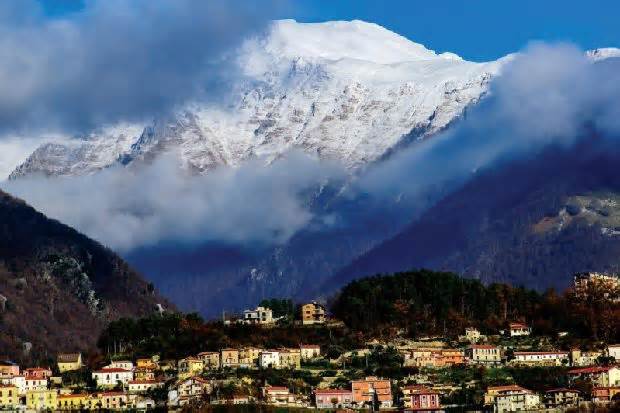Italo-Scots the Di Ciacca family return to their roots in the valley of Val di Comino
I hadn’t heard of the town of Picinisco, but the description – “nestled in the mountains between Rome and Naples” – and finding out about the large numbers who had swapped the surrounding area for Scotland piqued my interest. That, and the fact I was intrigued by the Italo-Scots Di Ciacca family returning to half a century of history and tradition in the valley of Val di Comino.
The story is fascinating. Cesidio Di Ciacca, now a retired corporate lawyer, grew up in Cockenzie with his family. They included siblings Carina Contini – now a doyenne of the capital’s food scene with Contini’s Restaurant on George Street, the Cannonball Restaurant and Bar in the shadow of Edinburgh Castle, and the Scottish Cafe & Restaurant at the Scottish National Gallery – and Mary Contini – director of Valvona and Crolla. His grandfather had left I Ciacca, the family’s hamlet in Val di Comino, and opened an ice cream shop in the East Lothian town in the 1920s.
I Ciacca fell into disrepair when the last member of the family living there died in 1969. Now, nearly 50 years later, Cesidio and his family – wife Selina, daughter Sofia and son Giovanni – have returned to their family’s roots and undertaken a regeneration project in a bid to reinvigorate the area.
We touch down in Naples and head south to the province of Frosinone. After a journey of around 90 minutes along increasingly rural and windy roads, we arrive at I Ciacca surrounded by a green sea of vines and olive trees. Despite it being mid-September, it’s a very warm day and the views down the valley are spectacular.
The fruits of the family’s labour are plain to see. I Ciacca has been renovated to a high standard, with a historic farmhouse cookery school, vineyards, a state-of-the-art winery and organic olive groves all on site.
Cesidio explains how education and knowledge of the land were crucial to the Di Ciaccas’ longevity at I Ciacca, and stresses the project’s end goal of turning the hamlet into a learning base. Using I Ciacca’s history, the focus is on the future – teaching young people about the land, growing produce, gastronomy, hospitality and more.
There are no dull stories when it comes to the Di Ciaccas. Over lunch, Cesidio and renowned oenologist Alberto Antonini – regarded as one of the world’s leading winemakers – take us through the early stages of the regeneration.
When plans were in their infancy, Alberto and Cesidio went for a walk across the abandoned land that had once played host to row upon row of vines before being reclaimed by forest and wild boars. The project gathered pace when Alberto inspected a handful of soil and realised the land was still ripe for wine-making.
Cesidio takes up the story, explaining how they moved quickly to clear the land and started planting vines, adhering to Alberto’s strict organic approach which also features concrete “egg” tanks to allow the wine to breathe and natural products to clean the winery and purify the wine itself.
I Ciacca’s first wine is Maturano, an indigenous local variety which has been all but lost for the past half-century. The family believes the grape may have been mentioned in the work of Roman poet Virgil, while an agricultural survey carried out by the government following the unification of Italy makes reference to Picinisco’s proclivity for the grape. Going back even further, a 16th-century report makes reference to the quality of white wine from the area.
A short drive away, the family’s albergo diffuso – or “scattered hotel” – is helping to revive Picinisco’s fortunes. Named Sotto le Stelle (Under the Stars), it’s an eco-friendly boutique hotel built in a former bishop’s palace in the heart of the village’s walls. Featuring one, two and three-bedroomed suites, there are private balconies and terraces offering guests a breathtaking view over the valley.
The alberghi diffusi concept came to life in Italy in the early 1980s, developed with a view to helping revive small, historic villages away from the usual tourist traps. Sotto le Stelle has helped Picinisco’s regeneration and has been followed by the reopening of La Crema di Berenice, a wonderful ice-cream parlour first opened in 1946, which specialises in traditional methods using just sugar, eggs and cream.
They’re not alone – Ben Hirst, an English chef previously based at a Michelin-starred restaurant in Rome, has made Picinisco his new home, moving into the Belle Époque-style Villa Inglese with a view to opening it as a gourmet eatery with luxury accommodation in the spring of 2020.
During our stay, we hike up Monte Meta in the Apennines. It’s a glorious day, the sun beating down and the mercury hitting 30C. Lorenzo, our
Throughout the hike, Lorenzo shows us where to forage for mushrooms, and takes us to an unassuming spot where we can fill our bottles with ice-cold water from an underground stream. He also tells us about the bears and wolves, and the chamois (mountain goats) that live on the mountain.
On our journey back down we stop off in a shady spot and tuck into an Italian picnic, most of which has come from Lorenzo’s garden.
When we are sitting in the piazza enjoying a last drink, a man at the next table, who has been embroiled in a lengthy conversation in the local dialect for the last 15 minutes, leans over.
“Are those Edinburgh accents I hear? Aye, thought they were. I’m from Juniper Green, you’re very welcome in Picinisco.”
Fact file
Flights to Naples from Edinburgh start from £115 return, jet2,com. Rooms at Sotto Le Stelle start at €84 per night, sottolestellepicinisco.it

Be the first to comment on "I Ciacca, Picinisco, Italy – Scotland on Sunday travel"